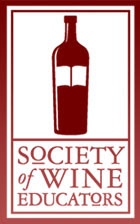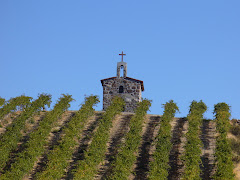 Okay, so I’ve been on a white wine kick as of late, highlighting some terrific Austrian wines, as well as sampling some amazing older vintages of German Rieslings. My boss always sees me bringing in a 2-, 3-, or 4-year old white and he commences to having a full-on Kinipshin. I try to explain to him that wines like Loire Chenins suchs as Vouvray and Savennieres, Spatlese and Auslese level Rieslings from Germany, and even Austrian Gruner Veltliners, Rieslings and other whites tend to age fairly well, some going as long as ten years or even longer.
Okay, so I’ve been on a white wine kick as of late, highlighting some terrific Austrian wines, as well as sampling some amazing older vintages of German Rieslings. My boss always sees me bringing in a 2-, 3-, or 4-year old white and he commences to having a full-on Kinipshin. I try to explain to him that wines like Loire Chenins suchs as Vouvray and Savennieres, Spatlese and Auslese level Rieslings from Germany, and even Austrian Gruner Veltliners, Rieslings and other whites tend to age fairly well, some going as long as ten years or even longer.It’s a common misconception that white wines are meant to drink young and red wines are meant to age. The plain truth of the matter is that 90% of all wine produced, regardless of its tint, is meant to be drank within its first 6 months. It’s that other 10% that has any true aging potential – and that is red, white and sparkling.
You have to take everything on a case-by-case (or I should be more precise in saying producer-by-producer) basis. The greatest disservice I think the wine critics such as Robert Parker, James Laube and Marvin Shanken (at Wine Spectator) and others have done is generalize vintages by giving a score to the overall year of each particular wine region. However, that translates to consumers as just a thumbs-up or thumbs-down review of a particular year.
Take for example the 1998 vintage (anyone remember this one?) Wine Spectator in particular absolutely murdered the California 1998s, yet consumers just heard the year and assumed everything from that vintage sucked. I was constantly pointing out to customers that 1998 in Australia, Rhone and Oregon were all phenomenal wines, and places like Piedmont and Washington State didn’t fare to badly either. Everything devolves into half-truths and full-blown misconceptions in the press, which is unfortunate. I feel for the real journalists in this business who get misquoted or have their stories taken out of context, yet it’s guys like Laube and Shanken from Spectator that really do the most damage in the long run.
I was inspired, if not outright taught, to look at a producer’s track record, how they can tak e a so-called bad year, and turn it around for them, make it work FOR them. Chateau Lynch-Bages in Pauillac would be an excellent example. Here is a producer that really doesn’t make a bad wine, even if the vintage is not all that great. It’s the winemaker that take lemons and make lemonade that stand out for me as a buyer, and I have worked for years to convey that in the selections that we offer here in our store.
e a so-called bad year, and turn it around for them, make it work FOR them. Chateau Lynch-Bages in Pauillac would be an excellent example. Here is a producer that really doesn’t make a bad wine, even if the vintage is not all that great. It’s the winemaker that take lemons and make lemonade that stand out for me as a buyer, and I have worked for years to convey that in the selections that we offer here in our store.
Take for example the 1998 vintage (anyone remember this one?) Wine Spectator in particular absolutely murdered the California 1998s, yet consumers just heard the year and assumed everything from that vintage sucked. I was constantly pointing out to customers that 1998 in Australia, Rhone and Oregon were all phenomenal wines, and places like Piedmont and Washington State didn’t fare to badly either. Everything devolves into half-truths and full-blown misconceptions in the press, which is unfortunate. I feel for the real journalists in this business who get misquoted or have their stories taken out of context, yet it’s guys like Laube and Shanken from Spectator that really do the most damage in the long run.
I was inspired, if not outright taught, to look at a producer’s track record, how they can tak
 e a so-called bad year, and turn it around for them, make it work FOR them. Chateau Lynch-Bages in Pauillac would be an excellent example. Here is a producer that really doesn’t make a bad wine, even if the vintage is not all that great. It’s the winemaker that take lemons and make lemonade that stand out for me as a buyer, and I have worked for years to convey that in the selections that we offer here in our store.
e a so-called bad year, and turn it around for them, make it work FOR them. Chateau Lynch-Bages in Pauillac would be an excellent example. Here is a producer that really doesn’t make a bad wine, even if the vintage is not all that great. It’s the winemaker that take lemons and make lemonade that stand out for me as a buyer, and I have worked for years to convey that in the selections that we offer here in our store.Nobody’s perfect, that’s for sure, but sometimes wineries such as Lynch-Bages put forth Herculean efforts to create consistently extraordinary wines using all that nature has provided, alongside the natural talent that winemakers such as Daniel Llose and Nicolas Lebenne (the winemaking team at Lynch-Bages) exemplify the point that you must not necessarily look at an overall vintage in order to assess the quality of a particular region, but take into account the presence of great talent.
In getting back to my point about white wines that CAN age and age well, here are a few we currently have in the store:
Philippe Delesvaux Anjou Aunthentique 2005: 5-7 years.
H. Donnhoff Riesling QbA 2007: anywhere from 3-12 years!
Poet’s Leap Riesling Columbia Valley 2007: possibly 7 years.
Fritz Haag Riesling Spatlese Brauneberger Juffer Mosel-Saar-Ruwer 2007: potentially up to 12 years.
Joh. Jos. Cristoffel Erbern Riesling Spatlese Erdener Treppchen Mosel 2007: Quite possibly up to 2030.
Hiedler Gruner Veltliner November 2007: Up to 2017.
You can check out the wines of Nicolas Joly from the Savennieres, or the Vouvray of Phillipe Foreau. There are white Bordeaux, Grand Cru Rieslings from the Alsace (from producers such as Weinback, Marcel Deiss and Kuentz-Bas) that all possess extraordinary aging potential. Look past all the stereotypes and make your own truth.











2 comments:
Amen. And don't forget about decanting whites either! Loire Chenins and White Burgundies especially.
Some other whites build for the cellar:
Chateau Musar Blanc
Sauternes
Vintage Champagne(!)
Friuli Whites
and the strange wines of Jura (according to John R @ Garagiste):
In a recent Jean Bourdy tasting of wines from Jura, a 1865 Jean Bourdy Chateau-Chalon (pre-Phylloxera Savignin) was opened - to which the current owner proclaimed:
“Who would have known?...we opened it too early”...
It's funny, I look and see that Steve Heimoff posted basically the same thing on the same day. Telepathic blogging maybe? Thanks for the additions, just helped make my point. You rock dude!
Post a Comment